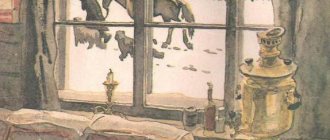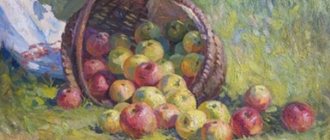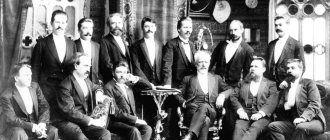4
Average rating: 4
Total ratings received: 530.
4
Average rating: 4
Total ratings received: 530.
“Antonov Apples” by I. Bunin is a panoramic image of the life of landowners, in which there was also room for a story about peasant life. The peculiarity of the work is its rich landscape sketches, from which unique autumn smells emanate. This is a striking example of poetic prose in Russian literature. The story is in the Unified State Examination codifier, so it is important to remember the basic information about it. Studying “Antonov apples in 11th grade. We offer a qualitative analysis of this work by I. Bunin.
The material was prepared jointly with a teacher of the highest category, Ilyina Galina Sergeevna.
Experience as a teacher of Russian language and literature - 36 years.
Brief Analysis
Year of writing - 1900.
History of creation - In 1891, I. Bunin stayed at the estate of his brother Evgeniy. Once, going outside, the writer caught the smell of Antonov apples, which reminded him of the times of the landowners. The story was written only 9 years later.
Theme - In this lyrical narrative, two themes can be distinguished: autumn in the village and poeticization of the life of landowners, regret about the passing noble culture.
Composition - The organization of the story is special, since the event line is very poorly represented in it. The main role is played by memories, impressions, and philosophical reflections that are associated with landscapes, smells, and sounds.
Genre : Short story, lyrical monologue.
Direction – Sentimentalism.
History of the story
In the early autumn of 1891, Bunin visited the village with his brother Evgeniy Alekseevich. And at the same time, he writes a letter to his common-law wife Varvara Pashchenko, in which he shares his impressions of the morning smell of Antonov apples. He saw how the autumn morning began in the villages and he was struck by the cold and gray dawn. The old grandfather’s estate, which now stands abandoned, also evokes pleasant feelings, but once upon a time it hummed and lived.
He writes that with great pleasure he would return to the time when landowners were honored. He writes to Varvara about what he experienced then, going out onto the porch early in the morning: “I would like to live like the old landowner! Get up at dawn, leave for the “departing field”, don’t get out of the saddle all day, and in the evening with a healthy appetite, with a healthy fresh mood, return home through the darkened fields.”
And only nine years later, in 1899 or 1900, Bunin decides to write the story “Antonov Apples”, which was based on reflections and impressions from visiting his brother’s village estate. It is believed that the prototype of the hero of Arseny Semenych’s story was a distant relative of the writer himself.
Despite the fact that the work was published in the year it was written, Bunin continued to edit the text for another twenty years. The first publication of the work took place in 1900 in the tenth issue of the St. Petersburg magazine “Life”. This story also had a subtitle: “Pictures from the book “Epitaphs.” For the second time, this work, already revised by Bunin, was included in the collection “The Pass” without a subtitle. It is known that in this edition the writer removed several paragraphs from the beginning of the work.
But if you compare the text of the story with the 1915 edition, when the story “Antonov Apples” was published in the Complete Works of Bunin, or with the text of the work in 1921, which was published in the collection “Initial Love,” then you can see their significant difference.
History of creation
The history of the creation of the work is connected with the writer’s trip to his brother Eugene. In a country estate, I. Bunin caught the smell of Antonov apples. The aroma reminded Ivan Alekseevich of the life of landowners. This is how the idea for the story arose, which the writer realized only nine years later, in 1900. “Antonov Apples” became part of Bunin’s cycle of epitaphs.
The story was first seen by the world in the year it was written in the magazine “Life”, published in St. Petersburg. Critics received it positively. But the publication did not mark the end of the work. Bunin continued to polish his creation for twenty years, so there are several versions of “Antonov Apples”.
Check out what else we have:
for the busiest -
Reader's diary “Antonov apples”
Analysis of the composition and problems of the story “Antonov Apples”
The work belongs to the short story genre in which there is a form of internal monologue. The story consists of four chapters, each of which contains a description of a new world. But, combining them together, we get a complete picture of the world, which Bunin so masterfully created.
First part: an amazing garden, its unity with nature, universal fragrance.
Second part: golden autumn, the aroma of apples, village chores are described.
The third part: the change from foggy autumn to harsh winter, along with which the spirit of the landowners, ready to leave their homes, fades away.
Part four: loneliness and melancholy
Analyzing the story “Antonov Apples,” Bunina will note that the work is filled with sounds, as if nature wants to convey something important to the reader. The sounds and noises only intensify towards the end of the story. Only Antonov apples remain unchanged. There is an effect of a closed space; it seems that there is nothing in the world except the estate. The story lacks a familiar plot, there is only a life cycle filled with feelings and emotions. As much as man experiences, so does nature. After all, everything in life is interconnected.
The main theme not only of this story, but of the writer’s entire work is the theme of Russia. Bunin is worried about the ruined noble estates and estates. This lyrical and soulful work seems to immerse you in the world of reality and a passing Russia. Bunin shows that with the disappearance of the smell of apples, the former Russia also leaves.
The characters in this story have no names. This technique is used to show that any person can be in the place of the characters; there is no specific type. However, along with the consistent change of seasons, the main character also changes. He grows from a child to a youth, from a youth to an adult, and then to an old man.
Subject
To grasp the essence of the story “Antonov Apples,” one should consider the main themes and problems of the work.
It is dominated by an autumn theme . The author reveals the beauty of nature at the time of its withering and the changes that autumn brings to human life. Then I.A. Bunin proceeds to describe the life of a landowner. The image of Antonov apples plays an important role in revealing both themes. These fruits have become a symbol of childhood, antiquity, intoxication with nature and serenity. This is the meaning of the title of the story.
The peculiarity of the work is that the lyrical component plays the leading role in it. It is not for nothing that the author chooses the first-person narrative form. This way the reader can get as close as possible to the narrator, see the world through his eyes, observe his feelings and emotions. The narrator of the work resembles the lyrical hero whom we are accustomed to seeing in Bunin’s poems.
First, the narrator describes early autumn, generously “sprinkling” the landscape with folk signs. This technique helps to recreate a rustic atmosphere. At the beginning of the story, the image of Antonov apples already appears. They are collected by peasants in the gardens of bourgeois gardeners. Gradually, the author moves on to a description of a bourgeois hut and a fair near it. This allows you to introduce colorful peasant images into the work. The first part ends with a description of an autumn night.
The second part begins again with landscape and folk signs. In it, Bunin talks about long-lived old people, hinting that his generation is much weaker than the past. In this part the reader can find out how wealthy peasants lived. The narrator describes their life with delight, not hiding the fact that he himself would like to live like that.
Memories take the narrator back to the times when his landowner aunt was alive. He enthusiastically tells how he came to visit Anna Gerasimovna. Her estate was surrounded by an apple orchard. The hero describes in detail the interior of the house, paying special attention to smells, the main one being the aroma of apples.
The third part of I. Bunin’s work “Antonov Apples” is a story about hunting - the only thing that “sustained the fading spirit of the landowners.” The narrator describes the preparations for the hunt, the process itself and the evening feast. In this part, another hero appears - the landowner Arseny Semyonovich, who pleasantly surprises with his appearance and cheerful disposition.
In the final part, the author talks about the death of landowner Anna Gerasimovna, landowner Arseny Semyonich and the elderly. The spirit of antiquity seems to have died along with them. All that remained were memories of the “small-scale life.” Nevertheless, I. Bunin concludes that she is also good, confirming this with a description of small-scale life.
The problems of the work are concentrated around the extinction of landowner culture and the death of antiquity.
The idea of the story is to show that the old days had a special charm, so descendants should preserve it at least in memory.
The main idea is that a person cherishes the memories that remain in his heart from childhood and youth.
Antonov apples - analysis
Ivan Bunin is a great author who was able to conquer the hearts of more than one generation of readers with his works. Every schoolchild knows the work “The White Poodle,” and teenagers and adults prefer to read his stories about love. “Antonov Apples” became the final work of Bunin’s early work, and thus it did not lose any of its depth and value.
The story was first published in 1900. As Bunin himself said, the impetus for writing the work was his brother’s garden, where there was always the smell of Antonov apples. When editing, the author omitted many pages describing the life of the nobles. He did this to significantly shorten the story.
The work belongs to the short story genre and consists of four chapters that are complete in meaning. The author with great skill created in each chapter a special and interesting world for the reader. Thus, the first part reveals the meaning of unity with nature, fragrance in the garden. The second is Village chores in the autumn. Third - along with the arrival of winter and the fading of autumn color, the souls of landowners who leave beautiful places fade away.
Time passes in the work, seasons change, but one thing remains the same and unchanged - the smell of Antonov apples. As in other works by Bunin or other authors, there is no complex plot here. The author depicts the life cycle of nature and man, which have a connection with each other. As the state of nature changes, the state of people's souls changes. The world in the story is narrowed to one estate, and it seems that apart from it nothing exists in this world.
The work contains a deep thought about Russia, as in other works of Ivan Bunin. There is a metaphor of nature as a homeland, which at one time smelled and bloomed, and along with the fading of the smell of Antonov apples, the former beauty of the estate, the noble family and the entire garden as a whole disappears. So Russia ceased to smell fragrant, and at the same time the majesty of the people living in it and the beauty of the country, created by human hands, disappeared.
The main character of the story does not have a name; this technique is used in order not to focus attention on this person, but only on his image, which is characteristic of any resident of Russia, who changes his age along with the seasons. When it was summer the hero was a boy, then a young man, an adult and an old man. Like a garden it grew, blossomed and withered.
The work “Antonov Apples” has the deepest meaning, which can be revealed to yourself again and again, like the hero of the story.
Composition
The compositional features of the work are manifested both at the formal and semantic levels. It is written in the form of memories of a lyrical hero. The main role in the story is played not by events, but by extra-plot elements - landscapes, portraits, interiors, philosophical reflections. They are closely intertwined and complementary. The main tool for their creation is artistic means, among which there are both original and folklore ones.
It is difficult to identify the elements of the plot - exposition, plot, development of events and denouement, since they are blurred by the indicated extra-plot components.
Formally, the text is divided into four parts, each of which is devoted to certain memories of the narrator. All parts are connected by the main theme and the image of the narrator.
The history of the creation of "Antonov Apples"
Ivan Alekseevich Bunin planned to write this work back in the early nineties of the 19th century. Then he was visiting his relative's estate. One day I went out onto the porch and smelled the amazing, unique smell of apples. At the same time, he experienced nostalgia for serfdom.
When analyzing “Antonov Apples,” it should be said that in this work the author glorified the old landowner life. The main theme of the story is lyrical memories of noble culture. Many of Bunin’s works, including “Antonov Apples,” are permeated with nostalgia for the past.
An analysis of a writer’s work involves a presentation of the main facts from his biography. As you know, Bunin left Russia. But this happened many years after the publication of the story. However, already at the beginning of the century, Russia was not the same as depicted in the work “Antonov Apples”. Bunin's heroes are images from a past, happier life.
The history of the creation of the story “Antonov Apples”
The story was published in the magazine “Life” in 1900. Inspired by a visit to his brother's estate, he wrote the work. According to Bunin, the garden smelled of Antonov apples, which you can’t breathe in! It is for them that the poet loves autumn.
Before the story was published, Bunin shortened its content. For example, the first page was completely removed. Some descriptions of noble life were also omitted.
Antonov apples - analysis of the story
essay on literature 11th grade
History of creation
The story “Antonov Apples” is one of the first prose works by I.A. Bunina. It was first published in the October 1900 issue of Life magazine.
Meaning of the name
Antonov apples or Antonovka are a special variety of apples with which the author associates the warmest and happiest memories. The peasants compared their well-being with their productivity: “A vigorous Antonovka - for a cheerful year,” “if an Antonovka crop is born, then the grain is born.”



